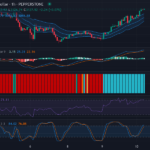Navigating Gold Prices Amidst U.S.-China Tariff Tensions: A Safe-Haven Analysis
Tháng 4 10, 2025
Bullish Surge Anticipated in Gold Vs US Dollar Amid Potential Overbought Market – 10/04/2025
Tháng 4 10, 2025Surge in the Australian Dollar: Implications of Trump’s Tariff Policy Pause
Recent developments regarding Donald Trump’s tariff policies have seen a noteworthy impact on global markets and, particularly, the Australian Dollar (AUD). The decision to pause higher tariffs for 90 days, coupled with the reduction of reciprocal tariffs to 10%, has been perceived as a stabilizing force amidst a climate of uncertainty in global trade. As indications of a more favorable trade environment emerge, the question that lingers is whether this positive momentum for the AUD can be sustained in the long run.
Global Trade Stability and the AUD’s Growth Potential
One of the key determinants of the Australian Dollar’s future performance is the overall stability of global trade. With Trump’s recent tariff decisions, there is a semblance of improved trade relations, which can significantly bolster investor confidence. A stabilized trade environment is critical for the Australian economy, which relies heavily on exports, particularly in resource sectors like minerals and agriculture. As trade tensions ease, Australia could see an uptick in demand for its goods, thus driving the value of the AUD higher.
Nevertheless, while the initial reaction to the tariff pause has been positive, the sustainability of this trend hinges on the continuation of favorable international trade dynamics. Any resurgence of trade disputes or the reinstatement of tariffs could undermine the tenuous gains that have been achieved. Consequently, the Australian government and exporters alike remain vigilant regarding future developments in the geopolitical landscape. As outlined in three strategic moves by China, these international relations shifts can have significant implications for the AUD.
Economic Indicators: Deciding Factors for Long-term AUD Trajectory
In addition to global trade stability, domestic economic indicators play a vital role in shaping the AUD’s trajectory. Metrics such as inflation rates and employment figures provide essential insights into Australia’s economic health and influence investor perceptions of the currency. For instance, if inflation remains in control and unemployment rates decrease, the RBA (Reserve Bank of Australia) may be encouraged to adopt a hawkish stance, potentially leading to interest rate hikes that could further bolster the AUD.
Conversely, negative domestic economic trends could exert downward pressure on the currency, regardless of external factors. Hence, while the pause on tariffs may support positive sentiments in the short term, the broader economic context within Australia is pivotal for the AUD’s longer-term prospects. Investors can learn from top investment mistakes to avoid to ensure they make informed decisions that consider these economic indicators.
Market Sentiment: The Emotional Reaction to Changes in Trade Policies
Investor sentiment remains another crucial factor influencing the stability of the AUD. The market’s immediate reaction to policy changes can lead to fluctuations in currency values based on perceived risks and opportunities. For example, if investors interpret the pause in tariffs as a precursor to a more sustainable peace in trade relations, renewed confidence could drive demand for the AUD. However, should sentiment shift due to other geopolitical events or unexpected economic data, volatility can ensue, underscoring the unpredictable nature of currency markets.
In conclusion, while the recent tariff pause presents a positive outlook for the Australian Dollar, the currency’s future remains contingent on a multitude of factors. Sustained improvements in global economic conditions, ongoing vigilance regarding trade disputes, and the management of domestic economic metrics will collectively dictate the potential for economic growth and stability in the AUD. As such, stakeholders continue to monitor developments closely, recognizing that the currency’s fate may still be subject to shifts in both domestic and international arenas. For insights into the strategic approach to value investing, one might consider the 3 reasons Greenblatt says value investing beats the market as part of their investment strategy during these fluctuating times.
